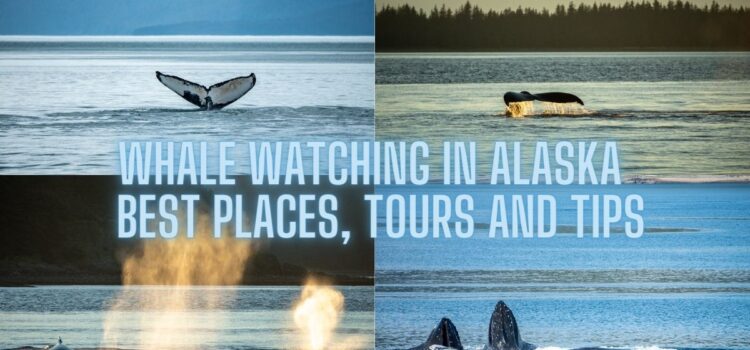
In Juneau, during June, the peak whale watching season occurs. Humpback whales migrate, offering rich encounters, making it the whale-watching Juneau best time. Witness breaching and bubble net feeding behaviors. Mornings bring heightened whale activity for better sightings. Afternoons showcase distinct patterns in whale behavior. Opt for sunset tours for unique lighting and quieter experiences. Whale movements are influenced by tides; high tide attracts active feeding. Weather affects visibility; clear skies and calm seas enhance experiences. Choosing experienced guides is key for enhanced sightings. Remember to dress appropriately and bring essentials. Timing with high tide is optimal for spotting whales. Adjust camera settings and use binoculars for better viewing.
Key Takeaways
– Peak morning activity in June provides optimal encounters with humpback whales.
– Afternoons see increased whale activity with distinct behavior patterns.
– Sunset tours offer unique lighting for photography and quieter experiences.
– High tide times enhance whale spotting due to active feeding behaviors.
– Clear skies and calm seas optimize whale-watching experiences in Juneau.
June – Prime Whale Watching Season
In June, humpback whales migrate to the waters near Juneau, making it the prime whale-watching season due to the abundance of these majestic creatures. Whale behavior during this time is particularly intriguing as the whales showcase a variety of activities such as breaching, tail slapping, and bubble net feeding. These behaviors provide a captivating spectacle for onlookers, allowing for a deeper appreciation of these marine giants.
For the best locations to witness these incredible displays, Auke Bay and Point Bridget State Park are top choices. Auke Bay, with its rich waters and ample food sources, attracts numerous humpback whales during their migration. Point Bridget State Park offers a more serene setting, ideal for observing whales in their natural habitat without the presence of large crowds. Both locations provide excellent opportunities to witness the grace and power of these magnificent creatures up close, creating unforgettable memories of your whale watching experience in Juneau.
Morning – Ideal Time for Sightings
You’ll notice that peak morning activity among whales in Juneau promises excellent opportunities for sightings.
Being an early bird grants you a significant advantage in encountering these majestic creatures.
The morning hours often boast prime viewing conditions, enhancing your chances of witnessing breathtaking whale behaviors.
Peak Morning Activity
At what time can the peak morning activity for whale sightings typically be observed in Juneau?
In Juneau, sunrise sightings offer an excellent opportunity to witness marine mammal sightings at their peak morning activity. During the early hours, as the sun starts to illuminate the waters, whales in the area tend to be more active, breaching, diving, and playing.
This period is characterized by heightened movement and social interactions among these majestic creatures. The calmness of the morning sea often allows for clearer visibility and a more serene whale watching experience.
Being present during this time enhances your chances of encountering these marine giants in their natural habitat, showcasing their grace and power against the picturesque backdrop of the Alaskan landscape.
Early Bird Advantage
Witnessing the early morning activity of whales in Juneau provides a valuable advantage for optimal sightings and interactions with these marine mammals. During the early morning hours, the waters are often calm, creating ideal conditions for whale watching.
The soft light of sunrise illuminates the surroundings, making it easier to spot the majestic creatures as they breach and feed. Whales tend to be more active during the early hours, increasing the chances of exciting encounters. Additionally, the lack of crowds during this time allows for a more intimate and peaceful experience with these magnificent animals.
If you seek the best opportunities for whale watching in Juneau, setting out in the early morning will offer you a unique advantage that late afternoon visits may not provide.
Prime Viewing Conditions
For optimal sightings and interactions with whales in Juneau, mornings offer prime viewing conditions due to the calm waters and increased whale activity. During the morning hours, weather patterns tend to be more stable, with reduced wind speeds and clearer skies, providing ideal visibility for spotting these magnificent sea creatures.
Optimal locations for whale watching in Juneau in the morning include areas where nutrient-rich waters attract whales, such as the Inside Passage or Auke Bay. These locations are known for their high concentration of marine life, drawing whales to feed and engage in various behaviors, offering spectators a captivating show.
Afternoon – Best Hours for Whale Watching
As the afternoon unfolds, peak whale activity tends to increase, offering a higher chance of encountering these majestic creatures breaching and feeding.
Weather conditions play a crucial role during this time, impacting visibility and sea conditions, influencing where and when whales may surface.
Tour availability also varies in the afternoon, with different options like smaller group tours or extended trips becoming more accessible, allowing for a tailored experience to witness these incredible marine mammals in their natural habitat.
Peak Whale Activity
During the afternoon hours, whale activity in Juneau peaks, providing optimal conditions for whale watching enthusiasts. Whales exhibit distinct behavior patterns during this time, often engaging in feeding, breaching, and social interactions.
Understanding their migration routes allows for better predictions of where they might surface, enhancing the whale watching experience. Humpback whales, known for their acrobatic displays, are commonly sighted during peak hours, showcasing their majestic flips and tail slaps.
Observing these magnificent creatures in their natural habitat during peak activity times offers a thrilling encounter with the marine world. Keep your eyes peeled for the tell-tale signs of whales breaking the surface, as these moments can lead to awe-inspiring sightings that will be etched in your memory forever.
Weather Conditions Impact
Optimal weather conditions in the afternoon significantly impact the visibility and overall experience of whale watching in Juneau. Temperature fluctuations play a crucial role in determining how comfortable and enjoyable your whale watching expedition will be.
In the afternoon, as the day progresses, there may be slight changes in temperature that could affect your level of comfort on the boat. Additionally, visibility is key to spotting these majestic creatures in their natural habitat. Wind patterns and ocean currents also influence visibility, as they can create ripples or waves that may obstruct the clear view of the waters.
Being mindful of these factors can enhance your chances of having a successful and rewarding whale watching adventure in Juneau.
Tour Availability Options
For the best whale watching experience in Juneau during the afternoon, consider exploring tour availability options that align with peak whale activity hours. Tour packages offered by local operators often cater to these optimal times, ensuring you have the best chance of spotting these majestic creatures in action.
These packages may include knowledgeable guides who can provide insights into the behaviors of whales and the surrounding marine ecosystem. Additionally, keep an eye out for group discounts that some tour companies offer, allowing you to enjoy this experience with friends or family at a more affordable rate.
Evening – Sunset Whale Watching Tours
As the sun sinks below the horizon, embarking on an evening sunset whale watching tour in Juneau offers a captivating opportunity to witness these majestic creatures in their natural habitat. Sunset cruises provide a unique lighting setting for wildlife photography enthusiasts, allowing for stunning shots of humpback whales breaching against the backdrop of the colorful sky.
During evening excursions, you may observe intriguing marine mammal behavior as whales start their nighttime activities. Humpbacks, known for their acrobatic displays, might engage in tail slapping or even cooperative bubble-net feeding as they prepare for the night ahead. The tranquil waters at dusk create a serene environment, enhancing the overall experience of witnessing these magnificent creatures up close.
Opting for a sunset whale watching tour not only offers a different perspective but also a chance to enjoy a quieter time on the water with fewer crowds. The peaceful ambiance as the day transitions into night adds an element of tranquility to your whale watching adventure.
Tides – Impact on Whale Activity
The ebb and flow of tides significantly influence the activity patterns of whales in the waters surrounding Juneau. Tidal patterns play a crucial role in shaping whale behavior and movements. Whales often follow the currents created by the changing tides, using them to navigate and find food sources. During high tide, nutrient-rich waters are brought to the surface, attracting prey and consequently, whales. This is a prime time to witness whales actively feeding and breaching.
Conversely, during low tide, the currents may push prey towards specific areas, leading whales to concentrate their feeding efforts in these locations. The fluctuating tides also impact whale migration, as some species take advantage of the currents to aid their journey to breeding grounds or feeding areas. Understanding these current effects on whale behavior can enhance the chances of successful whale sightings during your whale watching excursions in Juneau. Keep an eye on the tidal patterns to optimize your whale watching experience.
Weather – Influence on Sightings
Weather conditions play a crucial role in the frequency and visibility of whale sightings during whale watching expeditions in Juneau. The rainy season, typically from October to March, can lead to choppy waters and reduced visibility, making it challenging to spot whales during heavy rainfall due to the disturbance caused by raindrops on the water’s surface.
Fog is a common occurrence in Juneau, especially during the summer months. Mornings can be particularly foggy, affecting visibility out at sea. Whales may be harder to spot in these conditions, as their blows and movements can be obscured by the mist.
Optimal weather conditions for whale watching in Juneau include clear skies and calm seas. Clear skies provide excellent visibility, allowing you to spot whales from a distance and observe their behaviors more clearly.
It’s essential to be prepared for temperature changes during your whale-watching trip. Dressing in layers will ensure you stay comfortable as you navigate the varying weather conditions in Juneau.
Tours – Choosing the Right Operator
Considering the significant impact weather conditions can have on whale sightings, the choice of tour operator plays a pivotal role in maximizing your chances of encountering these majestic creatures in Juneau. When comparing operators, look for those with experienced guides who know the best spots and behaviors of whales.
Prioritize operators that offer small group tours, as these provide a more intimate and personalized experience. When booking, ensure flexibility in case weather conditions change abruptly. Safety measures should be a top priority; reputable operators will have safety briefings and provide necessary equipment like life jackets.
Additionally, inquire about the type of boats used – smaller vessels can often navigate closer to the whales for a more immersive experience. While researching, read reviews and testimonials to get an idea of the quality of service provided by each operator.
Tips – Enhancing Your Whale Watching Experience
For optimal whale watching in Juneau, timing your excursion to coincide with high tide can significantly enhance your chances of spotting these magnificent marine mammals. High tide brings a greater abundance of food closer to the surface, attracting whales to feed in shallower waters where they’re more easily observable.
1. Camera Settings for Capturing Breaching: Set your camera to a fast shutter speed to freeze the motion of breaching whales. Adjust the aperture to ensure proper exposure, and consider using burst mode to capture multiple shots in quick succession.
2. Binocular Tips for Spotting Distant Whales: When using binoculars, stabilize your hands by bracing your elbows on a solid surface. Scan the horizon methodically, focusing on areas with seabird activity or distinctive splashes that could indicate whale presence.
3. Learn Whale Behavior: Understanding whale behavior can help anticipate where they might surface next. Look for signs like spouts, dorsal fins, or flukes to track their movements effectively.
4. Dress Appropriately and Pack Essentials: Dress in layers to stay warm and comfortable during your whale-watching excursion. Bring essentials like sunscreen, water, snacks, and binoculars to enhance your overall experience.
Conclusion
You have learned that June is the prime whale-watching season in Juneau, with mornings being the ideal time for sightings due to the calm waters.
Afternoons offer the best hours for whale watching, while sunset tours provide a unique experience.
Tides and weather can impact whale activity, so choose a reputable tour operator for the best chance of spotting these majestic creatures.
Follow these tips to enhance your whale-watching experience in Juneau.









Comments
Best-Selling & Trendy Watches for Kids You Must Buy This Season